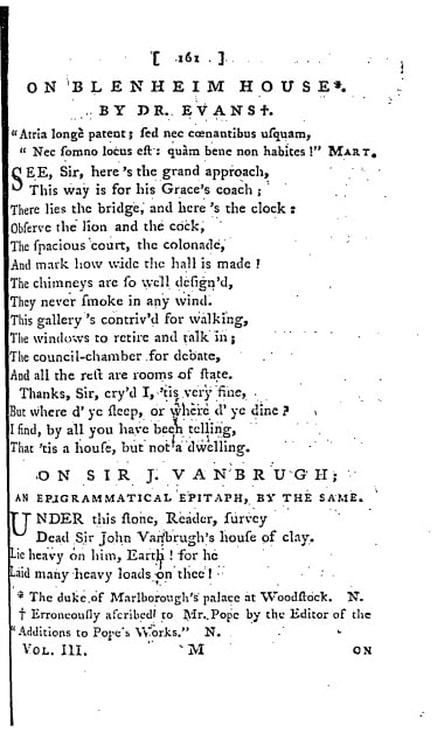
Authority Cited: Epitaph on Vanbrugh [Evans, Abel]
Author name and dates: Abel Evans (1679–1737)
The "heavy load" of Vanbrugh's Blenheim Palace
BKG Bio-tweet: St. John's Coll. Oxford degrees; cleric; satiric poet; best known as epigramist
Categories (list of works cited – preliminary)
Author name and dates: Abel Evans (1679–1737)
The "heavy load" of Vanbrugh's Blenheim Palace
BKG Bio-tweet: St. John's Coll. Oxford degrees; cleric; satiric poet; best known as epigramist
Categories (list of works cited – preliminary)
- Epitaph on Vanbrugh: On Sir John Vanbrugh (The Architect). An Epigrammatical Epitaph (1726); lie [BKG Note: SJ's pre-1755 source not yet identified; the epitaph is attributed to Evans in: A select collection of poems: with notes, biographical and historical, the Third Volume, 1780, London: printed by and for J. Nichols, Red Lion Passage, Fleet-Street (p.161); SJ quotes the last two lines of the epitaph, see image below. See also: Vanbrugh. The Epitaph appears to be an inversion of the sentiment in Epitaph 7.461, Meleager, in the Greek Anthology, translated in Yale Works of Samuel Johnson, Vol. 6, Poems, p.319, as "Hail Earth, Mother of all! Aesigenes was never a burden to thee, and do thou hold him without weighing heavy on him." (Thanks to R.D. Brown for pointing out that the translation is actually not by the Yale editors but borrowed from W. R. Paton in the Loeb edition, and that the relation to the Greek Anthology was noted by Richard Jodrell in Illustrations of Euripides on the Alcestis (1789), 177.)]
